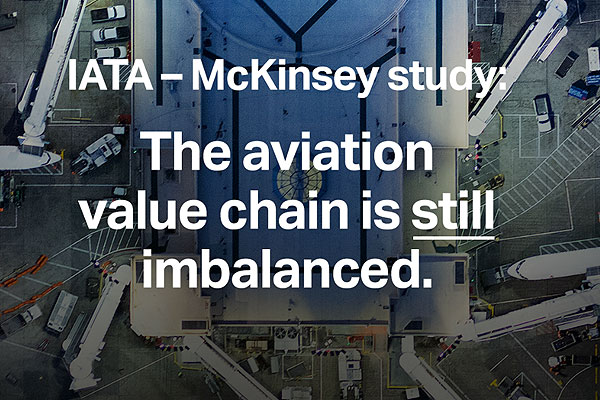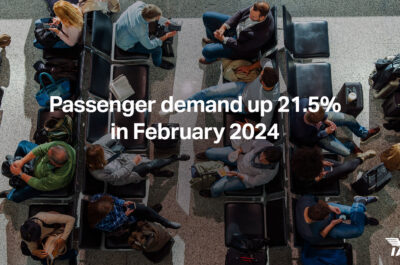While there is no clear path to rapidly re-balance the value chain, the study concludes that there are some key areas – including decarbonization and data-sharing – where working together and burden-sharing will mutually benefit all value chain participants.
GENEVA – The International Air Transport Association (IATA) and McKinsey & Company published a study of profitability trends across the aviation value chain showing that profitability varies widely by sector. The study also shows that in aggregate, airlines underperform on the financial return that an investor would normally expect.
While there is no clear path to rapidly re-balance the value chain, the study concludes that there are some key areas – including decarbonization and data-sharing – where working together and burden-sharing will mutually benefit all value chain participants.
Highlights from the Understanding the Pandemic’s impact on the Aviation Value Chain study include:
- Capital Destruction: Despite delivering consistent operating profits pre-pandemic (2012-2019), airlines collectively did not produce economic returns above the industry’s Weighted Average Cost of Capital (WACC). On average the collective Return in Invested Capital (ROIC) generated by airlines was 2.4% below the WACC, collectively destroying an average of $17.9 billion of capital each year.
- Value Creation: Pre-pandemic, all sectors of the value chain except airlines delivered ROIC in excess of the WACC, with airports leading the pack in the absolute value of return by rewarding investors with an average of $4.6 billion annually above the WACC (3% of revenue). When viewed as a percentage of revenue, Global Distribution Systems (GDSs)/Travel Tech firms topped the list with average returns of 8.5% of revenues above the WACC ($700 million annually), followed by ground handlers (5.1% of revenue or $1.5 billion annually), and Air Navigation Service Providers (ANSPs) at 4.4% of revenues ($1.0 billion annually).
- Pandemic Changes: Although the pandemic (2020-2021) saw losses across the value chain, in absolute terms airlines’ losses led the pack, with ROIC falling below the WACC by an average of $104.1 billion annually (-20.6% of revenues). Airports saw ROIC fall $34.3 billion below the WACC and generating the largest economic losses as a percentage of revenue (-39.5% of revenues).
"This research reaffirms that airlines improved their profitability in the years following the Global Financial Crisis. But it also clearly shows that airlines, on average, were not able to benefit financially to the same degree as their suppliers and infrastructure partners. Rewards across the value chain are also disproportionate to risk. Airlines are the most sensitive to shocks but have limited profits with which to build a financial buffer,” said Willie Walsh, IATA’s Director General.
The pandemic saw all players fall into economic losses. As the industry recovers from the crisis, the study’s most important question is: can a more balanced distribution of economic returns and risk be realized in the post-pandemic world?” said Walsh.
Several changes in the profile of airline economic returns are noted in the study:
- While network carriers underperformed the low-cost sector (LCCs) pre-pandemic, average economic returns by network carriers exceeded those of the LCCs during the pandemic. The gap between the two, however has narrowed as the recovery progressed.
- Airlines solely operating cargo flights have a profitable financial performance with an ROI of nearly 10%. Thus, the profitability of all-cargo carriers was the reverse of airlines carrying both passengers and cargo. By comparison, the performance of all cargo carriers is still well below the average ROIC for freight forwarders which began the crisis at nearly 15% of revenues and grew to 40% of revenues by 2021.
- Regionally, it was clear that in aggregate North American carriers entered the crisis with the healthiest balance sheets and strongest financial performance. The picture of recovery was less clearcut in 2021, but having fallen the deepest in the crisis, the trajectory of the region’s recovery is also the steepest.
Why do airlines generate insufficient economic returns?
An updated analysis of the forces shaping airline profitability originally done in 2011 with Harvard Business School’s Professor Michael Porter demonstrates there has been little positive change.
- Competitive Fragmented Industry: The airline industry is intensely competitive, fragmented and subject to high barriers to exit with low barriers to entry.
- Structure of suppliers, buyers and channels: A high concentration of powerful suppliers, the emergence of increasingly efficient alternatives to air travel, commoditized product offerings with low switching costs and a fragmented buyers’ community are characteristics of the operating environment.
“It is difficult to see how these entrenched forces will change significantly in the near term. In most cases the interests of those in the value chain are simply too divergent to work as partners to drive change that could meaningfully alter the profitability profile across the value chain. That is why IATA will continue to call on governments to better regulate our monopoly or near-monopoly suppliers like airports, ANSPs and GDSs,” said Walsh.
Recent IATA polling shows public understanding of the need to regulate monopoly suppliers. Some 85% of consumers polled in an 11-country survey agreed that the prices that airports charge should be independently regulated, like utilities.
Cooperation
The value chain study also revealed some areas of common interest where greater cooperation would deliver benefits for all. Two of the examples noted in the study include:
- Data-driven efficiency gains: Aviation generates vast amounts of data. At the operational level, sharing data to build a more complete picture of how day-to-day decisions impact customers, airports terminals, airline schedules/crew movements, and runway utilization is already helping to drive efficiencies for all industry players at some airports. This same principle can be applied across the industry to make better long-term decisions in areas including infrastructure development, process improvements, and skills development.
- Decarbonization: Achieving net zero carbon emissions by 2050 cannot be done by airlines alone. Fuel suppliers need to make sustainable aviation fuels available in sufficient quantities at affordable prices. ANSPs need to provide optimal routings that minimize emissions. Engine and aircraft manufacturers must bring to market aircraft that are more fuel efficient and take advantage of low or zero carbon propulsion means such as hydrogen or electricity. Those offering service in the airport environment will need to convert to electric vehicles.
"There is no magic solution to rebalance the value chain. But it is clear that the interests of governments, travelers and other value chain participants are best served by financially healthy participants – and particularly airlines. A combination of better regulation and cooperation in areas of mutual interest could move the needle. And there are at least two areas ripe for collaboration and burden sharing – pursuing data-driven efficiency gains and decarbonization,” said Walsh.
"We are proud to partner with IATA since 2005 on understanding the value created across the aviation value chain. Over that time, the aviation industries have seen several crises and comebacks. But never has the aviation value chain overall returned its cost of capital. Airlines have consistently been the weakest element, even in their best years not quite returning cost of capital. But there are win-wins, and companies across the value chain can work better together to serve customers, and improve value,” said Nina Wittkamp, Partner at McKinsey.
Tatiana is the news coordinator for TravelDailyNews Media Network (traveldailynews.gr, traveldailynews.com and traveldailynews.asia). Her role includes monitoring the hundreds of news sources of TravelDailyNews Media Network and skimming the most important according to our strategy.
She holds a Bachelor's degree in Communication & Mass Media from Panteion University of Political & Social Studies of Athens and she has been editor and editor-in-chief in various economic magazines and newspapers.
































































































































































































